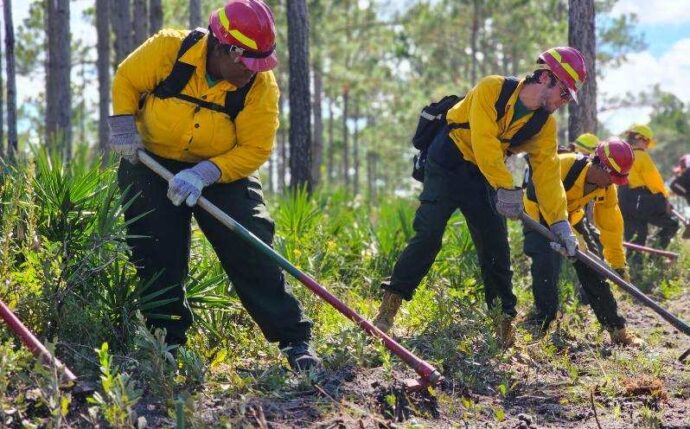
Conserving the Gulf, creating jobs: Reflections on building GulfCorps as a landscape conservation and stewardship program that weaves together workforce development and ecological restoration
By Jeff DeQuattro, GulfCorps program directorYoung adults living along the Gulf Coast, whose communities are regularly impacted by storms, flooding, or pollution, don’t often have a voice in the environmental movement. The GulfCorps program is a chance for them to be a professional in the field that manages their own environment.
****
Black Hawk helicopters swirled overhead, kicking up brackish spray in the Bayou Sauvage Urban National Wildlife Refuge. A seven-member crew from The Nature Conservancy’s GulfCorps Program waited on airboats below as the helicopters dropped bundles of discarded Christmas trees along the edges of the marsh.
The GulfCorps members, all between the ages of 22 and 26, then jumped into action, unhooking the large bundles from the hovering helicopters. Once released, these bundles of former Christmas trees, collected curbside after the holidays, would help build shoreline, slow erosion, and protect wildlife habitat in this important tidal marsh adjacent to Lakes Pontchartrain and Borgne in New Orleans.

Jay York, photo by Dakota Goff
For the members assisting in the operation, this project would be just one of many conservation jobs they’d perform over the course of their service with GulfCorps, a program designed to change lives as much as landscapes.
GulfCorps blends workforce development with hands-on conservation. It’s a collaborative effort between The Nature Conservancy and dozens of federal, state, and local partners—including NOAA, The Corps Network, The Ember Alliance, and the Student Conservation Association.
Crews perform jobs that help restore lands and waterways in the communities where many of the members grew up. Participants learn to clear trails, build oyster reefs, remove acres of invasive species, assist on prescribed burns, and operate chain saws.
Launched in 2017 in the wake of the BP Deepwater Horizon Oil Spill, GulfCorps focuses on projects that restore habitat across the five Gulf states — Florida, Alabama, Mississippi, Louisiana, and Texas. While they provide needed muscle on projects, the members also earn industry-recognized certifications, work experience, and professional skills that position them to land internships, jobs, and post-secondary educational opportunities in the conservation field. The program has a 91 percent job placement rate for graduates of GulfCorps.
From the beginning, GulfCorps’ mission has been to do conservation and restoration, but in a way that makes sure local people are employed in these projects and are benefiting from BP oil spill funding. GulfCorps engages communities that do not typically attract many conservation professionals.
To the program’s recruits, the outdoor, hands-on work is attractive, but so is the pay. This year, GulfCorps crew members earn $15 per hour, or the minimum wage in the state, whichever is higher. Since the program’s inception, GulfCorps has enrolled more than 600 people, who have worked over 500,000 hours and restored more than 32,000 acres across the five Gulf states–learn more from the GulfCorps dashboard.
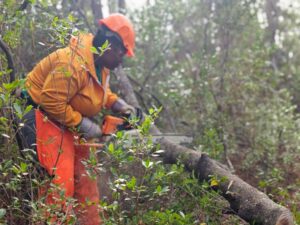
Alexis Powell, Photo by Jay York
“The numbers of acres of habitat that are being restored, the amount of invasive species that are being removed, all the actual on-the-ground work that is happening is really helping to make the environment in these coastal communities a lot more resilient, and at the same time, it is developing the next generation of environmental leaders,” said Dan Van Nostrand, Deepwater Horizon Implementation section chief for NOAA Fisheries, speaking at a GulfCorps orientation program.
The projects also have a big economic ripple effect. A recent NOAA Fisheries report, Restoring Habitat, Bolstering the Economy, and Supporting Jobs in Florida, shows the board impact of community-led restoration. The report, which includes projects performed by GulfCorps’ partners, “finds that $72.5 million invested across 12 habitat restoration projects in Florida is estimated to support jobs and wages and increase both spending and economic activity. In total, more than $100 million will be added to the economy.”
***
GulfCorps got its start thanks to a $7 million grant, funded by the RESTORE Act. Since then, the program has received additional funding through the RESTORE Act and NOAA’s Transformational Habitat Restoration and Coastal Resilience program. The most recent NOAA grant will carry GulfCorps through 2028, for a total investment in Gulf Coast of more than $31 million since the program’s inception.
Today, the program supports nine crews employed by four partner corps organizations operating across the five states. GulfCorps’ projects range from planting marsh grass and native trees to
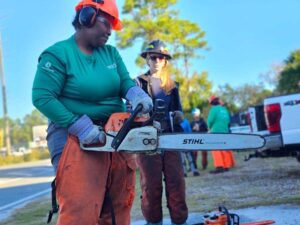
Photo by Jay York
building living shorelines, performing trail restoration, constructing boardwalks, and picking up debris, among others. Comprehensively, the focus is on projects that will improve each community’s resilience to impacts from environmental changes and disasters. GulfCorps monitors the work to ensure it is producing the desired ecological results.
For the crew members, the program provides much more than a pay check. “These are folks who traditionally don’t have a direct career path,” said Joe Taylor, executive director of Franklin’s Promise Coalition/FloridaCorps, a partner of GulfCorps. “But through leveraging support, all of these doors open for these young people that really allows them to take care of the place they call home.”
Alexis Powell, for example, had worked in housekeeping and was eyeing a job as a security guard before she found a FloridaCorps job listing. A native of Panama City, Florida, and at age 25, she had a high school diploma and zero experience in conservation work. “I saw the opportunity to be in nature, and as a woman using a chain saw and doing prescribed burns, it just seemed like a way to challenge myself,” said Powell, who now serves as the community outreach and education coordinator for FloridaCorps in St. Andrew Bay. “When I cranked that chainsaw or set that burn or cut down a tree, it made me feel very powerful, like I could do anything if someone was there to teach me and support me.”
Powell is particularly proud of the tree planting and oyster reef restoration work that FloridaCorps has performed in her own community after the devastation of Hurricane Michael.
Beyond the outdoors experiences, the program also sharpened Powell’s interpersonal skills. “When I graduated from high school, I didn’t feel like I did my best. But in GulfCorps, I’ve learned how to write and how to articulate,” she said. “I also have learned how to talk to people from different backgrounds. A lot of us don’t have the opportunities that other people have. People can stay in trouble because they don’t have the support. But GulfCorps gives you that support.”
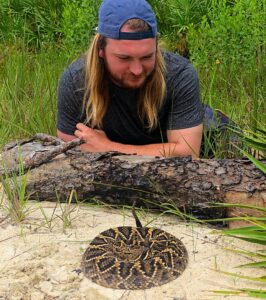
Photo by Dakota Goff
When Jay York first spotted a FloridaCorps’ job listing, he had a one-track plan: To earn as many certifications as he could get and then move on. Four years later, he’s now on staff and recently taught a class on field herpetology for the new cohort of GulfCorps members at the program’s 2025 orientation week in Fairhope, Alabama.
“This is my first time teaching a class at an orientation, and it feels like coming full circle,” said York, who has a YouTube channel, “Getting Lost with Jay York,” where he “spreads knowledge and appreciation for the species that normally go unnoticed.”
Right from the start, York quickly excelled at FloridaCorps, being promoted to crew leader within his first year. “They told me when I started that you get out of it what you put in,” he said, “and I looked at it as a way to get to a career in conservation.”
For each year of service, FloridaCorps members accrue financial awards that can be used for education. York hopes to one day use his awards to go to college. “My dream is to eventually become a biologist and maybe work for the state,” he said.
***
The Gulf Coast is an incredibly important ecological landscape and one that is vulnerable to degradation, and it has been rewarding to watch the way that this program has advanced critical ecological outcomes over the last eight years. But what has also been rewarding has been witnessing how this program recognizes and celebrates the community connection to landscape, and elevates workforce development as a long-term strategy for advancing better futures for our lands, waters, and communities.
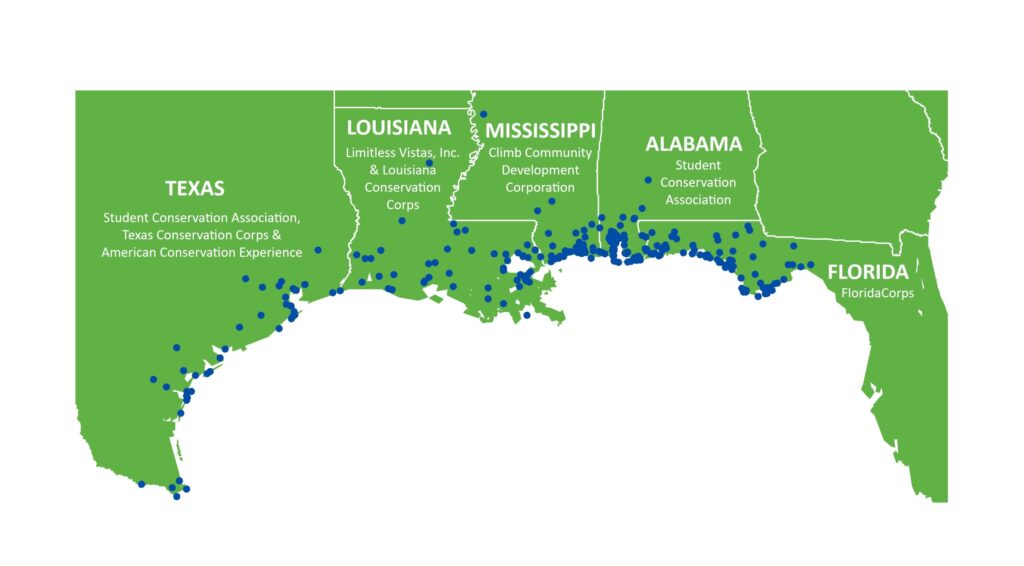
As I reflect on GulfCorps and the past eight years, I want to share a series of lessons learned that could be relevant to the success of landscape conservation and stewardship activities elsewhere. These factors include:
- You can’t do it alone: Across the nine organizations that help implement GulfCorps, we have around 35 staff that spend part of their time supporting 70 to 90 members each year, who are working on nine different projects at any given point, anywhere from South Padre Island, Texas, to Tallahassee, Florida. It takes a highly efficient team to keep up with thousands of acres worked, training around 70 people annually in federal-level prescribed fire and chainsaw operations and placing 91% of program graduates in jobs after their terms. I’m grateful for the team, and I love to brag that half of the staff are GulfCorps graduates themselves.
- Murphy’s law is all around you when working with crews of young adults: Some of these GulfCorps members have never been in the woods or in nature before joining this program. If you’re willing to foster the growth of young folks, you must expect a learning curve on both sides.
- The importance of being on site and hands-on: The best projects are the ones where the resource manager at the preserve or on the site engages with the crew through teaching or workforce development learning. An engaged project partner gets the best results from the project and inspires the members along the way. GulfCorps members really look up to our project partners.
From climate change, habitat fragmentation and land use change, pollution, and more, our landscapes are facing increasing threats. In the face of such threats, I am struck by the notion that our landscape conservation and stewardship efforts need to strengthen the connection and relationship of people to place. In GulfCorps, we see an innovative and powerful example of a program that creates pathways for strengthening those relationships and supporting the next generation of conservation and stewardship leaders.
